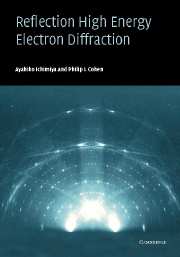Book contents
- Frontmatter
- Contents
- Preface
- 1 Introduction
- 2 Historical survey
- 3 Instrumentation
- 4 Wave properties of electrons
- 5 The diffraction conditions
- 6 Geometrical features of the pattern
- 7 Kikuchi and resonance patterns
- 8 Real diffraction patterns
- 9 Electron scattering by atoms
- 10 Kinematic electron diffraction
- 11 Fourier components of the crystal potential
- 12 Dynamical theory – transfer matrix method
- 13 Dynamical theory – embedded R-matrix method
- 14 Dynamical theory – integral method
- 15 Structural analysis of crystal surfaces
- 16 Inelastic scattering in a crystal
- 17 Weakly disordered surfaces
- 18 Strongly disordered surfaces
- 19 RHEED intensity oscillations
- Appendix A: Fourier representations
- Appendix B: Green's functions
- Appendix C: Kirchhoff's diffraction theory
- Appendix D: A simple eigenvalue problem
- Appendix E: Waller and Hartree equation
- Appendix F: Optimization of dynamical calculation
- Appendix G: Scattering factor
- References
- Index
17 - Weakly disordered surfaces
Published online by Cambridge University Press: 06 July 2010
- Frontmatter
- Contents
- Preface
- 1 Introduction
- 2 Historical survey
- 3 Instrumentation
- 4 Wave properties of electrons
- 5 The diffraction conditions
- 6 Geometrical features of the pattern
- 7 Kikuchi and resonance patterns
- 8 Real diffraction patterns
- 9 Electron scattering by atoms
- 10 Kinematic electron diffraction
- 11 Fourier components of the crystal potential
- 12 Dynamical theory – transfer matrix method
- 13 Dynamical theory – embedded R-matrix method
- 14 Dynamical theory – integral method
- 15 Structural analysis of crystal surfaces
- 16 Inelastic scattering in a crystal
- 17 Weakly disordered surfaces
- 18 Strongly disordered surfaces
- 19 RHEED intensity oscillations
- Appendix A: Fourier representations
- Appendix B: Green's functions
- Appendix C: Kirchhoff's diffraction theory
- Appendix D: A simple eigenvalue problem
- Appendix E: Waller and Hartree equation
- Appendix F: Optimization of dynamical calculation
- Appendix G: Scattering factor
- References
- Index
Summary
Introduction
The goal of this chapter is to develop both a quantitative and qualitative understanding of the diffraction from disordered systems as measured by actual instruments. We start by examining the diffraction from well-ordered GaAs and determine the changes produced by small amounts of disorder. To some extent this has also been how our historical understanding has progressed, beginning with well-ordered molecular beam epitaxy (MBE) surfaces of GaAs and Si. At the start of efforts to use MBE for the growth of high-quality films, the cause of the diffraction streaks was not completely clear. It was known that the films were of very high quality, from their electrical properties and X-ray diffraction spectra; hence the idea of finite crystallite size as discussed by Raether (1932) was not felt to apply. Some discussions examined the role of thermal diffuse scattering, and this can certainly be important. But for systems of interest in MBE, for example GaAs(100), it quickly became apparent that steps on the surface, and in some cases anti-phase disorder, produced the streaks that were typically observed.
One of the clearest examples of the role of steps is the change in the diffraction pattern one observes when growth is initiated on GaAs(100). This is a surface that is easy to prepare, using current technologies, without significant extended defects. Figure 17.1 shows an example of the diffraction patterns before and after growth has begun.
- Type
- Chapter
- Information
- Reflection High-Energy Electron Diffraction , pp. 234 - 259Publisher: Cambridge University PressPrint publication year: 2004

